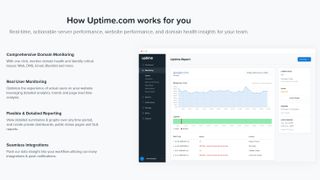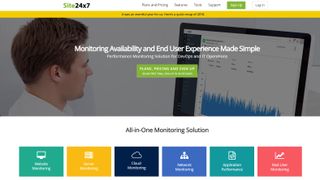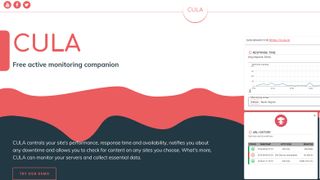Best website monitoring software
Websites go down all the time – that’s one fact of life as a webmaster or a sysadmin. Downtime can lead to significant loss of income during peak trading season and can negatively impact reputation, especially for small businesses that do not have the goodwill of Amazon or Walmart.
Another little known drawback to downtime is that it can affect your site’s ranking on search engines like Google. Downtime and load time are factors that search engines consider in order to rank sites on their search results pages. A site that is down regularly is likely to gradually sink down in SERP, resulting in fewer visits and ultimately even less sales.
This sort of scenario can be avoided, though, by using software that monitors your website and can detect when it goes down, or indeed something else bad happens. And once an event has been identified – the site is down, slow, hacked, and so on – an alert is usually sent, and there might even be a level of automation attached to it.
Website monitoring, however, encompasses so much more than this: you can monitor a whole website or even a subset of pages, web applications (known as Application Performance Monitoring), the performance of the website (which would include load time), the API (Application Programming Interface), real user monitoring, server monitoring and much more.
Below are the best website monitoring services that, our experts believe, will fulfill the needs of any SMB wanting to monitor the uptime, downtime and loading time of their website.
- Also take a look at the best web hosting services of 2019

1. Uptime.com
Best overall website monitoring service
Excellent value for money
Powerful feature set
Lacks an intermediate tier
Other than having a great URL, Uptime.com has a straightforward, easy to understand product that attracts clients of all sizes. The company has a lot of Fortune 500 organizations among its customer base: SAP, Kraft, and BNP Paribas to name a few.
With the firm’s cheapest package – which starts at $8 (£6.20) per month – 20 items can be monitored at 60-second intervals from the US; that’s 864,000 checks over a month. Included in all plans are content matching, unlimited API calls, port/SSL monitoring, third-party integrations as well as virus and malware scanning via Google and Yandex.
Spending extra will get you more checks, more territories, transaction checks and real user monitoring (RUM) checks, a longer data retention period as well as extra features like user accounts, single sign-on (SSO) and premium support.
There’s no free tier, but would-be buyers can avail themselves of a 21-day trial across all the paid-for tiers, with no credit card required, and three useful free tools that’ll give them a taste of what to expect from the website monitoring service. Uptime.com also provides a free public status page for dozens of companies (including popular web hosting outfits) and you can even subscribe to alerts.

2. Pingdom
Best website monitoring service for business
Proven monitoring capabilities
‘Film strip’ for transaction monitoring
You only get SMS credit
Maintenance windows not available on cheaper plans
Pingdom is regarded by many as the leader of the website monitoring market with nearly 900,000 customers worldwide including the likes of Walmart, Salesforce and Coca-Cola. It focuses on website performance and availability monitoring, meaning it looks at whether the website is up, and whether it loads as expected.
As with rivals, it offers 60-second checks, and gives subscribers 10 of them on its cheapest package which costs $11.95 (£9.30) per month. We like the fact that the company offers unlimited data retention, but it’s a shame about the lack of call capabilities. Only SMS is available although there is integration with the likes of Slack, OpsGenie or Pagerduty.
Note that Pingdom sits alongside other Solarwinds products (AppOptics, PaperTrail and Loggly) to provide a one-stop-shop for businesses looking to monitor almost everything that is connected.
All Pingdom tiers come with a free 14-day trial but you can also use its website speed test to test the load time of a page (or an index page) and analyze it to find bottlenecks.
One outstanding feature is ‘film strip’ where a screenshot of the elements present on the page being monitored is captured every 500ms for the duration it takes to load the complete page. This is subsequently converted into an animation that can then help the webmaster discover how long it takes for critical elements to appear on the page, potentially allowing for better optimization of the site.

3. Site24x7
Best for multiple websites
Good value for money
Price per server or website
Add-ons come in handy
Bewildering array of choice
ManageEngine’s Site24x7 is an offshoot of popular SaaS outfit Zoho, which ‘dogfooded’ this product before making it available to the general public.
In its simplest form, Site24x7 is a powerful website monitoring solution that scales all the way to become an all-encompassing, full-blown powerhouse that can do application performance monitoring and infrastructure monitoring for thousands of servers and websites simultaneously. That’s great for DevOps teams who want to monitor and troubleshoot applications, servers and network infrastructure, including private and public clouds.
The cheapest tier gives you the ability to monitor 10 websites or servers with one synthetic web transaction with the (rare) ability to buy more add-ons if needed – that might come in handy as the lowest RUM (real user monitoring) pageview count stands at only 100K.
All tiers have a 30-day free trial period. Site24x7 distinguishes between basic monitors and advanced monitors: web page speed and website defacement for example count as advanced monitors, while a pure HTTP request is deemed basic.
The website monitoring service also provides far more free tools than its competitors. However, the sheer breadth and depth of Site24x7’s offerings runs the danger of confusing novice users who only want to check their sites for availability.

4. Cula.io
Best if you want a free service
Free
Very simple to use
No SMS or voice call alerts
120-second checking interval
Speaking of dogfooding, as with our previous solution, here’s another which took this route. Cula hails from Poland and was developed primarily for in-house use before being opened to anybody.
It offers an attractive free plan that allows for the monitoring of 50 URLs (each with five content checks) and five servers with 10 parameters each. You will be alerted by email, over Slack, Discord and Pushover if there are any server issues.
Note that you get a 120-second checking interval even on paid accounts, and 180-days of history storage. Paying for the service gets you more URLs, more parameters, custom agent-less application performance monitoring, longer history storage and more content checks per URL.
There’s a nifty little demo version that doesn’t require you to create an account. The dashboard of the service is very easy to use and the Cula team deliberately kept things simple. There’s no native mobile app, transaction monitoring, advance reporting capabilities or maintenance scheduling, but you wouldn’t need those anyway if you’re after a basic website monitoring service on a budget.
We also liked the ability to come up with your own scripts to monitor almost anything: from your laptop’s battery to a weather station.

5. UptimeRobot
Cheap if you only want to monitor uptime
Superb value for money
Up to 20,000 monitors!
SMS/voice quota doesn’t renew every month
Limited functionality
UptimeRobot is a bit of a veteran having been launched at the beginning of this decade. It was one of the first to offer a free service which is still running and boasts up to 50 monitors (URLs, servers, keywords or ports), 5-minute checking intervals and 2-months of log storage.
Upgrade to the Pro Plan to get the monitoring interval reduced to 60-seconds with 20 SMS or phone calls, 12 months of logs, SSL monitoring, advanced notifications, maintenance scheduling and custom HTTP headers and statuses.
We liked the fact that the cost of adding more monitors is reasonable, down to as little as $0.0325 per month when buying 20,000 on an annual contract – the cheapest on the market.
However, if you want more advanced features, you will need to look elsewhere. UptimeRobot provides basic performance monitoring (limited to response time) and the main monitoring locations are US-based primarily. As with Cula, there are no multi-user features, no mobile apps or transaction monitoring.